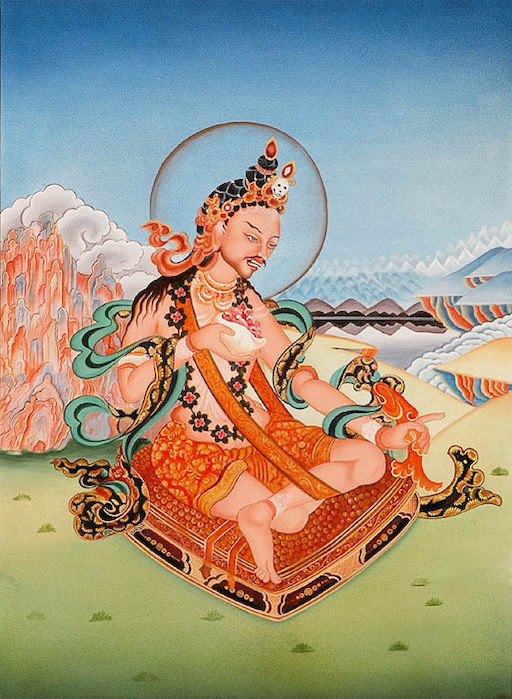Tilopa yogin, he was enigmatic, reclusive, mystical, knowledgeable
Tilopa exemplified the characteristics of a yogin: he was enigmatic, reclusive, mystical, knowledgeable, and taught through symbols that he expected Naropa to decipher and clarify. He also challenged Naropa’s egoism and violated his notions of monkhood by assigning him responsibilities. Over time, Naropa gradually liberated himself from his mental inclinations, and ultimately, Tilopa imparted his lessons to him. These sets consisted of psycho-physical yogas specifically created to modify the state of consciousness in order to enhance intuitive comprehension of the Dharma.
Specifically, these yogas allowed a practitioner to immediately attain personal experiential understanding of the concept of Emptiness (sunyata), rather than only comprehending it as a philosophical idea. Naropa, in his teachings, imparted the knowledge of the Six Yogas of Naropa, which eventually became renowned. These yogas, when combined with a thorough understanding of the tantras, were taught by Naropa. The core of the teachings is centered around Mahamudra, which involves directly perceiving the essence of oneself and the nature of reality. All other aspects, whether abstract or based on human experience, only served as tools or reinforcement for this individual understanding of the truth.

The conflict between the monk and yogin is evident in the narrative of Buddhism’s transmission from India to Tibet. King Trisong Deutsan extended an invitation to the esteemed scholar Santarakshita (750-802 CE) to introduce the teachings of Dharma in the Land of Snows. However, only individuals who have sufficient sophistication were able to comprehend and benefit from his teachings. Furthermore, he faced the obstacle of local malevolent spirits who thwarted his efforts to finish the construction of the Samye monastery by demolishing any progress made.
Padmasambhava, a renowned yogin also known as Guru Rimpoche, was subsequently summoned. Through his charm and intellectual prowess, he successfully dominated the local religious beliefs. By assuming the combined mythologies of each specific area, he conquered the supernatural beings associated with mountains, caves, and gorges, and designated them as guardians of the Dharma by a solemn pledge. The first introduction of Buddhism to Tibet laid the foundation for its practice and teachings. However, subsequent conflicts with the native shamanic religion (Bon) and political turmoil ultimately led to the downfall of the unified Tibetan state.
A select few members of the Royal Family sought sanctuary in the western region of the country, specifically in Guge, located southeast of present-day Ladakh, where they founded a new kingdom. The comprehension of the Dharma had declined and, specifically, the interpretation of the Tantras had become muddled. King Yeshe O, who was deeply religious, dispatched missions to India. As a result, Atisa Dipamkara (982 – 1054 CE) visited Tibet and successfully revived the Dharma in its original and untainted state. Atisa also established the Kadampa, a group of celibate monks, which became the first Tibetan Buddhist order famed for its strict discipline and purity.
The proliferation of monasteries led to a significant surge in the translation of texts and the advancement of scholarly activities. However, not all devout individuals were willing to practice celibacy, refrain from getting married, completely avoid alcohol, possess little wealth, and dwell in a single location. Tibetans are a homogeneous ethnic group, and new routes emerged shortly afterwards. Marpa (1012-1096CE) was a married individual who, driven by religious fervor, embarked on multiple extensive voyages to India. Specifically, he actively pursued Naropa, who ultimately conveyed to him the knowledge he had been seeking.
Marpa then went to Tibet and imparted his teachings to select cohorts who willingly congregated and resided in close proximity to his abode. Clearly, he possessed a temperament prone to anger and was a teacher who had high expectations. One day, Milarepa (1040-1123CE) approached him in pursuit of the Dharma. This individual has experienced a tumultuous existence and, utilizing occult practices, has engaged in severe unlawful activities as a means of seeking retribution against family members who have harmed him and his mother.
Marpa subjected him to strict discipline, assigning him menial jobs and eroding his self-centeredness through the use of sarcasm and clever remarks. On multiple occasions, Milarepa was on the verge of giving up, and it was solely due to the benevolence of Marpa’s wife that the chaotic home remained intact. Marpa eventually acknowledged the exceptional talent and aptitude of Milarepa’s religious calling and imparted to him the complete teachings.
Milarepa thereafter retreated to secluded caves for extended durations, subsisting on nettles and enduring harsh winters by harnessing the strength of his yoga practice. Whenever he was asked, he would impart knowledge by spontaneously singing songs, which have become highly cherished pieces of literature in Tibetan culture.